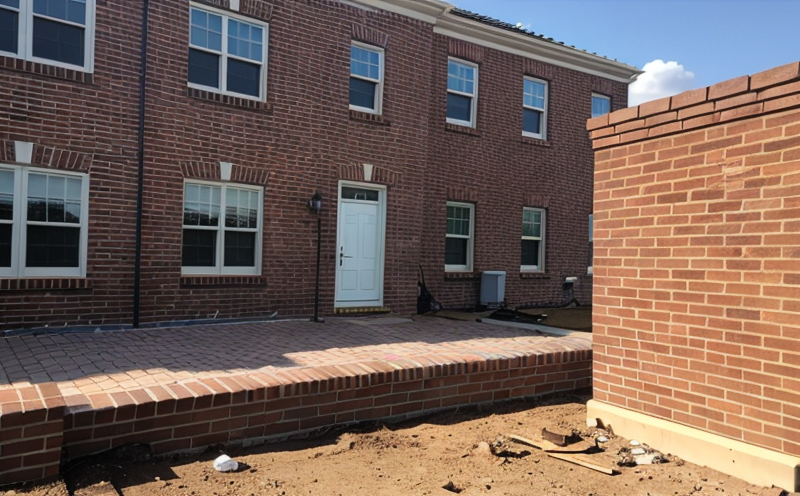ASTM C67 Modulus of Rupture Evaluation
The ASTM C67 Modulus of Rupture (MOHR) Test is a fundamental procedure used to evaluate the compressive strength and modulus of rupture of masonry units such as bricks. This test is critical in ensuring that materials meet specific performance standards, thereby guaranteeing their suitability for use in construction projects.
The ASTM C67 test involves subjecting a specimen to progressively increasing axial loads until failure occurs. The key parameters include the size and shape of the brick specimens, which are standardized according to ASTM specifications. The load at which failure occurs is measured accurately using high-precision testing equipment. This value provides insight into both the strength and ductility of the material.
The test apparatus typically consists of a hydraulic or motor-driven loading frame capable of applying controlled loads up to several hundred kilonewtons (kN). Specimens are placed within the machine, ensuring they remain centered during compression. The testing process is carefully monitored with strain gauges and displacement sensors to ensure accurate measurement.
The specimen preparation is critical for obtaining reliable results. Bricks must be free from cracks, chips, or other defects that could affect test outcomes. Specimens are usually cut according to specified dimensions, ensuring consistency across all samples tested. The drying process is also carefully controlled to eliminate moisture content variations between specimens.
Once prepared, the brick specimens are placed in the testing machine and subjected to increasing loads until failure. The load at which failure occurs is recorded along with any relevant deformation data. This information helps determine both the compressive strength and the modulus of rupture of the material.
The ASTM C67 test results provide valuable insights into the durability and reliability of masonry units used in construction projects. Compliance with this standard ensures that materials meet stringent quality control criteria, enhancing overall project performance and safety.
Environmental factors such as humidity and temperature can significantly impact the accuracy of test results. Therefore, controlled environmental conditions are essential during specimen preparation and testing to ensure consistent outcomes.
- Controlled Environment: Specimens should be stored in a controlled environment with stable humidity levels before testing.
- Standard Specimen Dimensions: Specimens must conform to specified dimensions according to ASTM C67 for accurate results.
- Load Application Rate: The rate at which loads are applied affects the test outcome, so it should be consistent and controlled.
The ASTM C67 Modulus of Rupture Test is a cornerstone in ensuring that masonry materials meet critical performance requirements. By adhering to this standard, construction professionals can enhance project quality and safety while meeting regulatory compliance demands.
Quality and Reliability Assurance
The ASTM C67 Modulus of Rupture Evaluation is integral to the broader process of ensuring high-quality masonry materials. This test plays a crucial role in maintaining reliability across construction projects by providing consistent and accurate data on material performance.
By conducting this test, laboratories can ensure that masonry units meet specified strength requirements. This enhances confidence in material performance, reducing risks associated with substandard products. The standardized procedures of ASTM C67 contribute to the overall quality assurance framework, making it easier for stakeholders to verify compliance and trustworthiness.
The results from this test are used not only by construction professionals but also by regulatory bodies to ensure that materials meet strict standards. This ensures consistency across projects, promoting a higher level of safety and reliability in the built environment.
For quality managers and compliance officers, relying on ASTM C67 Modulus of Rupture Evaluation offers peace of mind regarding material integrity and performance. By integrating these tests into procurement and development processes, organizations can ensure that only high-quality materials are used in construction projects.
Environmental and Sustainability Contributions
- Eco-Friendly Materials: ASTM C67 Modulus of Rupture Evaluation supports the selection of sustainable masonry units, which can contribute to green building initiatives. These materials are often derived from recycled or locally sourced resources.
- Resource Efficiency: By ensuring that masonry units meet high performance standards, this test contributes to efficient resource use in construction projects. This minimizes waste and reduces environmental impact.
- Emissions Reduction: The consistent quality of materials ensured by ASTM C67 Modulus of Rupture Evaluation can lead to more energy-efficient buildings, reducing overall emissions and promoting sustainable development.
The test also supports the lifecycle assessment (LCA) process by providing data that helps in evaluating the environmental impact of different masonry units. This information is crucial for architects, engineers, and policymakers aiming to design and implement environmentally friendly construction practices.
By incorporating ASTM C67 Modulus of Rupture Evaluation into procurement and development processes, organizations can contribute significantly to sustainability goals while maintaining high-quality standards in their projects.
Use Cases and Application Examples
The ASTM C67 Modulus of Rupture Evaluation is widely used in various sectors where masonry units are critical components. Here are some key application examples:
- Residential Construction: Ensuring that bricks used in residential buildings meet strength and durability standards to enhance safety.
- Commercial Structures: Providing reliable data for the selection of masonry units in large-scale commercial projects, ensuring longevity and performance.
- Infrastructure Development: Supporting the construction of durable infrastructure such as bridges, roads, and tunnels by validating material quality.
- Renovation Projects: Evaluating existing bricks to determine their suitability for renovation or replacement in historic buildings.
In addition to these sectors, ASTM C67 Modulus of Rupture Evaluation is also used in research and development (R&D) initiatives aimed at improving masonry unit performance. This test helps researchers understand material behavior under different conditions, leading to innovations that enhance construction practices globally.
Engineers and architects often use the results from this test as part of their design process, ensuring that materials are selected based on verified strength characteristics. This approach not only enhances project quality but also supports compliance with international standards like ISO 14025 for environmental labeling and declaration.





